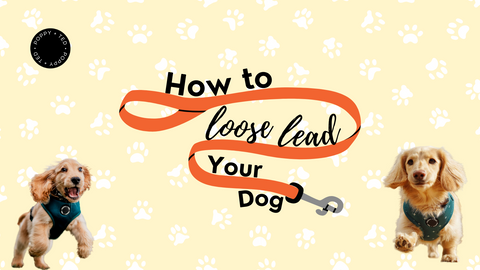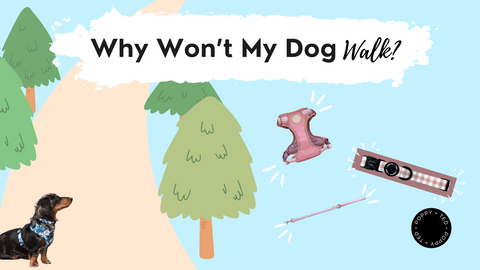Walking your dog should be a pleasant and enjoyable experience for both you and your furry friend. However, if your dog constantly pulls on the lead, it can turn a leisurely stroll into a tug-of-war. Don't worry; we're here to help! In this guide, we'll share effective tips and advice to help you loose lead train your dog so that you can enjoy peaceful walks together.
What is Loose Lead Training?
Before diving into the tips and techniques of loose-lead training, it's important to understand what this training method entails.
Loose lead training, also known as loose leash walking or loose lead walking, is a method of teaching your dog to walk calmly and comfortably beside you while on a lead. The goal is to eliminate the constant pulling and tugging that can turn a walk into a frustrating and exhausting experience for both you and your dog.
The essence of loose lead training lies in teaching your dog to walk on a slack leash, which means there should be no tension in the lead as you walk together. Instead of your dog dragging you in various directions, they learn to walk calmly at your side, matching your pace and direction.
10 Tips to Loose Lead Train Your Dog
Loose lead training is an essential skill that can make walks with your dog a joyous experience. By using positive reinforcement, consistency, and patience, you can teach your furry friend to walk comfortably beside you at your pace. Remember that each dog is unique, so adjust your training approach as needed to suit your dog's temperament and learning style. With time and dedication, you'll both be enjoying peaceful and enjoyable walks together.
1. Choose the Right Equipment:
Before you start training your dog to walk on a loose lead, ensure you have the right equipment. A well-fitting harness and a comfortable lead are essential. Consider using a no-pull harness that discourages pulling without causing discomfort to your dog.
2. Exercise Before Walks:
A tired dog is generally more focused and easier to train. Give your dog some exercise in your yard or play a game of fetch before heading out for a walk. This will help release excess energy and make the training session more effective.
3. Teach Basic Obedience Commands:
Before you can expect your dog to walk nicely on a lead, they should understand basic commands like "sit," "stay," and "heel." Spend time reinforcing these commands in a controlled environment before practising them on walks.
4. Use Positive Reinforcement:
Positive reinforcement is a powerful tool in loose-lead training. Reward your dog with treats and praise when they walk beside you without pulling. Use high-value treats to motivate them and make the training experience enjoyable.
5. Start in a Quiet Environment:
Begin training in a quiet, distraction-free area like your backyard or a peaceful park. Once your dog becomes proficient in loose lead walking in a controlled environment, gradually introduce more distractions and new environments.
6. Practice Short Sessions:
Short, frequent training sessions are more effective than long, exhausting ones. Aim for 10-15 minute training walks and gradually increase the duration as your dog becomes more skilled.
7. Be Consistent:
Consistency is key to success in dog training. Always use the same cues and commands, and reinforce good behaviour with rewards. Avoid reinforcing bad behaviour unintentionally by not allowing your dog to pull at any time.
8. Use the "Stop and Go" Technique:
If your dog starts to pull, stop walking immediately and wait for them to return to your side. Once they do, praise them and continue walking. This method teaches your dog that pulling leads to a halt in the walk, while walking nicely is rewarded with forward movement.
9. Be Patient:
Remember, loose lead training takes time, and every dog learns at their own pace. Be patient and stay consistent with your training efforts. Avoid using harsh corrections or punishments, as these can harm the bond between you and your dog.
10. Seek Professional Help if Needed:
If your dog's pulling behaviour persists despite your best efforts, consider enlisting the help of a professional dog trainer. They can provide personalised guidance and training techniques tailored to your dog's specific needs.
Embark on Stress-Free Walks with Poppy + Ted
In the journey to enjoying peaceful and harmonious walks with your furry companion, loose lead training is the path to success. By understanding the principles of this training method, staying patient, and being consistent with positive reinforcement, you can transform those frustrating tugs and pulls into leisurely strolls by your side.
At Poppy + Ted, we understand that having the right accessories is essential in making your training efforts more effective and enjoyable. Our selection of high-quality dog leads, harnesses, and collars is designed to provide comfort, safety, and control, making the training process smoother for both you and your dog.
Invest in the right gear, apply the tips and techniques from this guide, and watch as your dog transforms into the perfect walking companion. Say goodbye to those pulling struggles and hello to enjoyable, stress-free walks with your beloved pup. Shop with Poppy + Ted today, and let's embark on this training journey together!



